- docs
- FlowFuse User Manuals
- Using FlowFuse
- Getting Started
- Static asset service
- Bill of Materials
- FlowFuse Concepts
- Instance States
- Changing the Stack
- Custom Hostnames
- Custom Node Packages
- DevOps Pipelines
- Environment Variables
- FlowFuse Expert Assistant
- FlowFuse File Nodes
- FlowFuse MQTT Nodes
- FlowFuse Project Nodes
- FlowFuse Tables
- Groups
- High Availability mode
- HTTP Access Tokens
- Instance Settings
- Logging
- persistent-context
- Role-Based Access Control
- Shared Team Library
- Snapshots
- Team Broker
- Teams
- User Settings
- FlowFuse API
- Migrating a Node-RED project to FlowFuse
- Device Agent
- Device Agent
- FlowFuse Device Agent Introduction
- Installation
- Quick Start
- Register your Remote Instance
- Running the Agent
- Deploying your Flows
- Hardware Guides
- FlowFuse Cloud
- FlowFuse Cloud
- FlowFuse Self-Hosted
- Quick Start
- Installing FlowFuse
- Overview
- Configuring FlowFuse
- DNS Setup
- Docker install
- Docker from AWS Market Place
- Docker on Digital Ocean
- Add Project Stacks on Docker
- Docker Engine on Windows
- Email configuration
- First Run Setup
- FlowFuse File Storage
- Install FlowFuse on Kubernetes
- Upgrading FlowFuse
- Administering FlowFuse
- Administering FlowFuse
- Configuring Single Sign-On (SSO)
- Licensing
- Monitoring
- Telemetry
- User Management
- Support
- Community Support
- Premium Support
- Debugging Node-RED issues
- Contributing
- Contributing to FlowFuse
- Introduction
- Adding Template Settings
- API Design
- Creating debug stack containers
- Database migrations
- FlowFuse Architecture
- Local Install
- State Flows
- Device Editor
- Invite External Users
- User Login Flows
- Reset Password Flow
- Project Creation
- Instance states
- User Sign up Flow
- Team creation Flow
- Team Broker
- Working with Feature Flags
FlowFuse Cloud
FlowFuse Cloud is a hosted service allowing users to sign-up and start creating Node-RED instances without having to install and manage their own instance of FlowFuse. The Concepts remain the same, but we run the platform for you.
14-day Free Trial
When users sign-up to FlowFuse Cloud they get a 14-day free trial of the platform. This is a great way to start using FlowFuse and discover a lot of the value it provides.
Users can end their trial by heading to the Billing page of their team and setting up their payment information. This includes the option to pick which plan you want to upgrade the team to.
Otherwise, at the end of the 14-day trial period, any instances created in the team will be suspended. This means they will no longer be running and the editor will not be accessible. Users will need to add their Billing details at which point they will be able to restart their suspended Node-RED instances.
We will email users about their trial when it is nearing the end to ensure they know what is happening.
Billing
Customers are billed at the team level for each Node-RED instance they create. This is a recurring monthly charge. See the Billing page for more detailed answers about billing.
Support
Premium customers can get support by filing a ticket. We offer support for the FlowFuse application and your account, any issues relating to Node-RED such as your flows or a 3rd party node should be raised in the community forum.
Requesting a new verification email
When a user signs up for FlowFuse Cloud an email will be sent to verify it. If this email doesn't get delivered one can be resend by signing in to FlowFuse and click the button to resend it.
Team Types
FlowFuse Cloud has three different Team Type aimed at different sorts of users
Starter
Good for getting to know the platform, allows 2 small Instances, 2 Devices and 2 Team members
Team
Has access to more features e.g.
- Shared Team Library
- Project Nodes
- Team-based Dashboard/API security
- Email alerts for Instance crashes
- Has access to larger Instance Types
Also includes 5 Instances in the base price
Enterprise
All features from the Team Level plus
- HA for Instances
- SSO
- Better Support SLA
- MQTT Broker
Includes 10 instances and 20 MQTT Clients in the base price
Changing Team Type
You can change Team Type by selecting the "Team Settings" option from the left hand menu, then clicking on the "Change Team Type" button
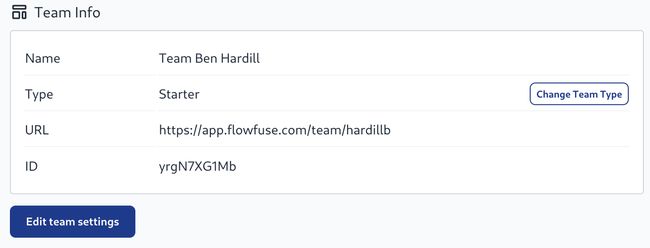
From here you will be presented with a choice of Team Types. You will not be able to downgrade to a lower Team Type if you already have more resources than allowed at that level. Please Suspend or Delete any no longer required Instances or Devices.
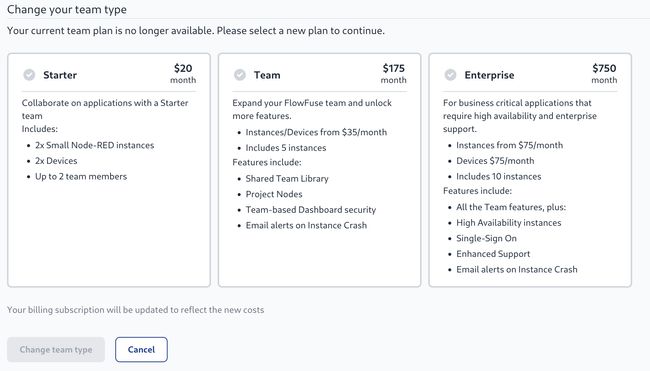
Node-RED on FlowFuse Cloud
FlowFuse currently offers Node-RED 4.x, 3.x and 2.x to customers. When creating a new instance a stack is chosen, which later can be upgraded to a later version.
Each Node-RED can install custom modules as advertised in the Flow Library.
Note that some modules have dependencies on system libraries or other components that are not available within the FlowFuse container images we use. Those modules cannot be used within FlowFuse Cloud. If you have a particular requirement, please do contact us so we can discuss what options may be available.
Cloud Instance Sizes
The different sizes of Cloud Instances relate to how much memory and CPU is made available to them.
Memory tends to be the main limiting factor for a Node-RED instance. The following table shows what is currently allocated by instance size.
| Size | Memory (RAM) |
|---|---|
| Small | 256MB |
| Medium | 768MB |
| Large | 3840MB |
Medium and Large instance types require the Teams or Enterprise tier.
Use of the File System
FlowFuse Cloud hosted instances have access to a persistent file-system that will retain the files stored on it across restarts of the instance.
A quota limit is applied to how much data can be stored, which varies based on the Team type.
| Team Type | File Storage Quota (per instance) |
|---|---|
| Starter | 1GB |
| Team | 10GB |
| Enterprise | 100GB |
Files can be manually uploaded to an instance using the Static Asset Service.
Node-RED Context
Node-RED Context can be used to store small pieces of application state within the runtime. By default, this is stored in memory only.
FlowFuse Cloud provides an optional context store that can be used to persist the data.
The amount of data that can be stored in context is determined by the Team type.
| Team Type | Context Store Quota (per instance) |
|---|---|
| Starter | 10MB |
| Team | 100MB |
| Enterprise | 1GB |
Network Connections
HTTP(S) & Websockets
Node-RED exposes an HTTPS interface on port 443 with each instance having its own hostname (example.flowfuse.cloud). Plain HTTP requests to port 80 will receive a redirect to HTTPS on port 443. You MUST connect using the hostname not the IP address to reach your Node-RED instance. Websocket connections over SSL (wss:) are also supported.
The payload size per request is limited to 5MB, which is the Node-RED default. When a request exceeds this limit, the whole request is rejected with a 413 Payload Too Large error.
TCP and UDP
The default TCP and UDP nodes have been removed from the Node-RED palette. This is because it is not possible to route these sorts of connections to the container running Node-RED inside the FlowFuse Cloud platform.
MQTT
MQTT Connections to an external broker using the standard MQTT nodes will work fine as the connection is initiated by Node-RED.
FlowFuse provides an MQTT broker for general use by Enterprise Team's Node-RED instances. See the following section.
Also the Project Nodes can be used to easily pass messages between Node-RED instances running in the platform.
Enterprise Team Broker
Both Team and Enterprise level teams come with their own MQTT broker. You can provision clients from the broker tab in the left hand menu.
Enterprise level Teams can register up to 20 and Teams level Teams can register up to 5 clients as part of their plan. The ability to purchase additional packs of clients will come in a near future release.
The broker is available on broker.flowfuse.cloud and supports the following connection types:
- MQTT on port
1883 - MQTT over TLS on port
8883 - MQTT over secure WebSockets on port
443
When creating clients you can specify a username, but it will prepended to the the Team's id e.g. alice will become alice@32E4NEO5pY. Clients must also use the username as the MQTT Client ID in order to connect.
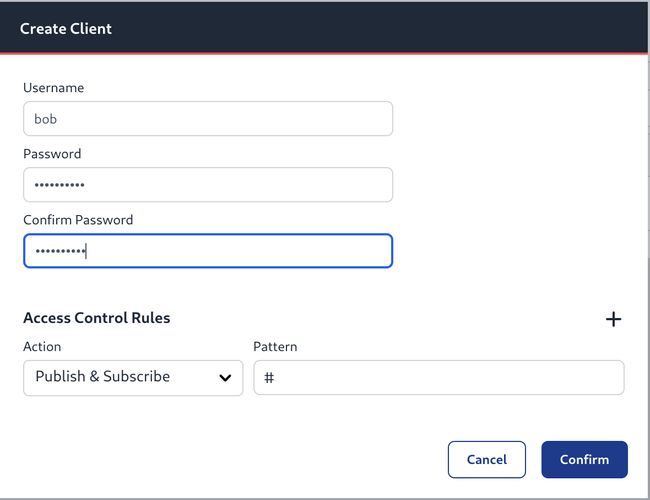
e.g.
mosquitto_sub -u "alice@32E4NEO5pY" -i "alice@32E4NEO5pY" -P "password" -h broker.flowfuse.cloud -t "#"
Or in Node-RED as follows
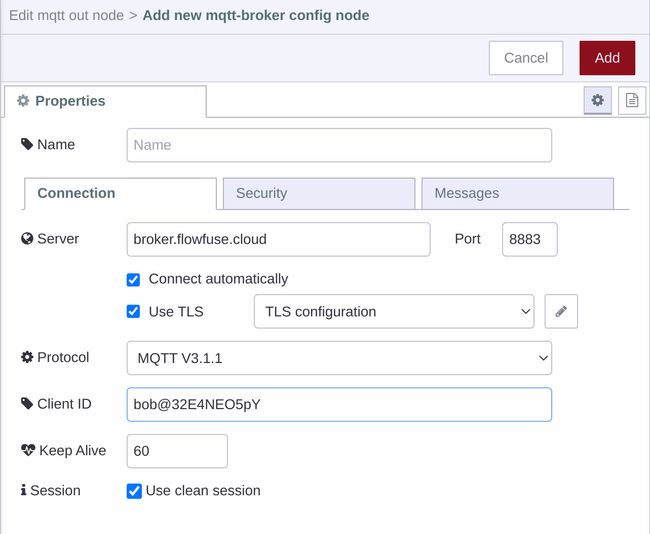
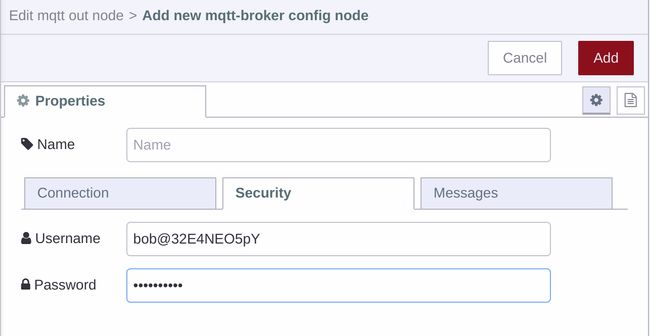
IP Addresses
Outbound connections from FlowFuse will always come from the IP address 63.33.85.112.
This can make access to a remote database or corporate network possible where those systems are protected by IP address filtering firewalls.
All incoming connections MUST use the hostname and not an IP address.
Data Security
FlowFuse Cloud is hosted on Amazon Web Services. The following statements apply to data handling within the platform:
- The underlying database use the industry standard AES-256 encryption algorithm to encrypt the stored data.
- Persistent storage offered to Node-RED instances uses AES-256 encryption algorithm to encrypt data and metadata at rest.
- The network load balancer uses the latest recommended AWS Network Security policy. This enforces TLS1.2 as a minimum.
Single-Sign On
FlowFuse supports configuring both SAML and LDAP based Single Sign-On for particular email domains.
This can be configured on request for FlowFuse Cloud by submitting a support request via our Contact Us page.
For SAML providers, you must have the ability to configure a SAML endpoint on your Identity Provider, and have the authority to configure SSO for your email domain.
We have currently validated our SSO support with the following Identity Providers:
- Microsoft Entra
- Google Workspace
- OneLogin
- Keycloak
If you are using a different Identity Provider, please still get in touch, and we can evaluate what will be required to enable it.
Custom Hostnames
FlowFuse Cloud can support custom hostnames for instances in Enterprise teams.
This allows you to point your own subdomain, such as dashboard.example.com at one of your instances.
See Custom Hostnames for more information.
Removing your account
Before you can delete your account, teams you own must either be deleted or have at least 1 other owner. Once this is done, you can remove your account by going to the "User Settings" page and clicking the "Delete Account" button.
See also: cancelling your subscription.